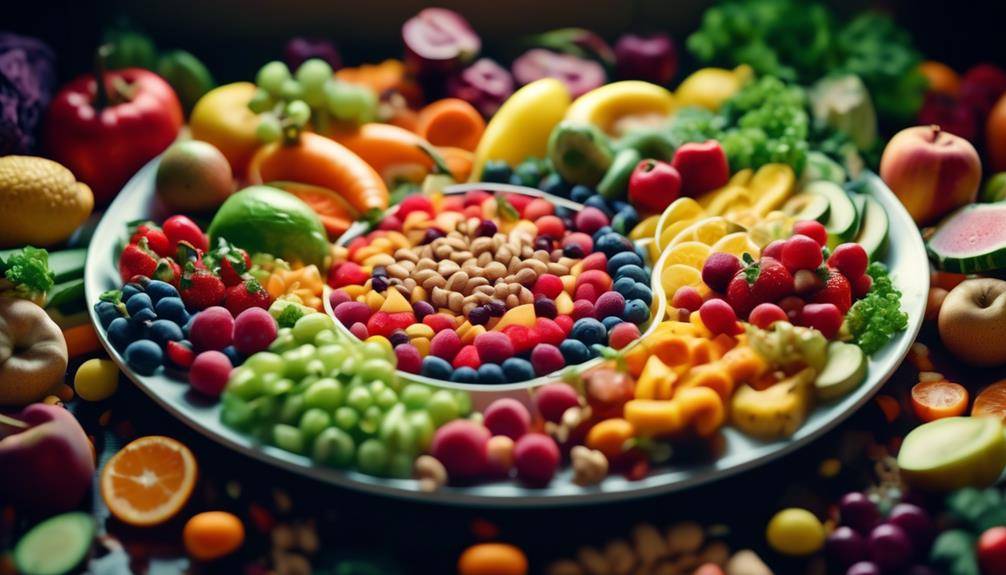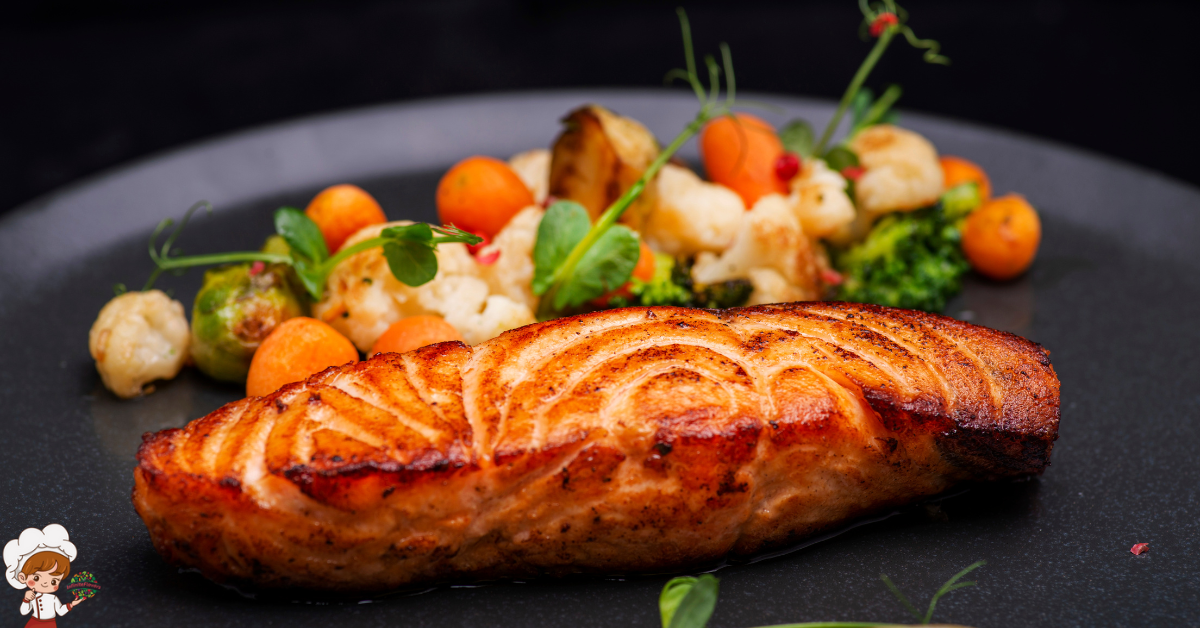The Best Classic Lebanese Dishes With A Modern Twist

Are you tired of the same old hummus and falafel? Well, get ready to tantalize your taste buds with classic Lebanese Dishes With A Modern Twist. Imagine a refreshing tabbouleh salad with a surprising ingredient that takes it to a whole new level of flavor. But that’s just the beginning. From reinventing the traditional mezze platter to fusion flavors like Lebanese-Mexican shawarma tacos, there’s a world of culinary innovation waiting for you. So, get ready to embark on a gastronomic journey that will leave you craving for more.
Modern Take on Traditional Tabbouleh
If you’re looking to elevate the refreshing flavors of traditional tabbouleh, consider a modern twist that adds an unexpected and delightful twist to this classic Lebanese dish. Modern tabbouleh variations are all about pushing boundaries and experimenting with new ingredients and flavors, while still staying true to the essence of the dish.
One innovative tabbouleh presentation that has gained popularity is the use of quinoa instead of bulgur wheat. Quinoa adds a nutty flavor and a light, fluffy texture to the dish, making it a perfect alternative for those who are gluten intolerant or simply looking for a healthier option. The combination of fresh herbs, juicy tomatoes, crisp cucumbers, and tangy lemon juice with quinoa creates a harmonious blend of flavors that is both refreshing and satisfying.
Another modern take on traditional tabbouleh is the addition of fruits such as pomegranate seeds or diced mango. These fruity accents add a burst of sweetness and a vibrant pop of color to the dish, taking it to a whole new level. The sweetness of the fruits complements the tanginess of the lemon juice and the freshness of the herbs, creating a delightful balance of flavors.
Innovative tabbouleh presentations also include incorporating different types of greens, such as kale or spinach, into the dish. These greens not only add a nutritional boost but also bring a unique flavor profile to the tabbouleh. The earthiness of the greens adds depth to the dish, while still allowing the other ingredients to shine.
Reinventing the Lebanese Mezze Platter
When it comes to reinventing the Lebanese Mezze Platter, modernizing traditional flavors is key. By incorporating innovative presentation techniques, such as deconstructed dishes or creative plating styles, the Mezze Platter can be transformed into a visually stunning and enticing experience. Additionally, fusion dishes that combine Lebanese ingredients with other culinary influences can add a unique twist to this traditional spread, appealing to a wider range of palates.
Modernizing Traditional Lebanese Flavors
To give traditional Lebanese flavors a modern twist, culinary innovators have been reinventing the Lebanese mezze platter with creative and innovative ingredients that tantalize the taste buds. This trend of modernizing traditional Lebanese flavors is not limited to just the mezze platter, but extends to other aspects of Lebanese cuisine as well. For example, chefs are now experimenting with incorporating Lebanese flavors into international cuisine, creating fusion dishes that combine the best of both worlds. This infusion of Lebanese flavors into dishes from different cultures adds a unique and exciting twist to traditional Lebanese flavors.
Additionally, there is a growing interest in modernizing traditional Lebanese desserts by using unconventional ingredients and techniques, resulting in delightful and unexpected flavor combinations. Through these culinary innovations, traditional Lebanese flavors are being reimagined in ways that appeal to a contemporary audience while still honoring the rich heritage of Lebanese cuisine.
Innovative Mezze Presentation
Culinary innovators have revolutionized the traditional Lebanese mezze platter by presenting it in innovative and visually stunning ways. They have taken this beloved assortment of small dishes and elevated it to new heights through creative seafood dishes and imaginative presentations. Here are three examples of how the mezze platter has been reinvented:
- Seafood Tower: Imagine a tower of fresh seafood, with layers of grilled shrimp, marinated octopus, and seared scallops. This impressive centerpiece not only showcases the flavors of the sea but also adds a touch of elegance to the mezze experience.
- Deconstructed Sushi Rolls: Taking inspiration from Japanese cuisine, chefs have deconstructed traditional Lebanese dishes like kibbeh and transformed them into bite-sized sushi rolls. These rolls are filled with a mix of lamb, bulgur, and spices, and are served with a side of tahini dipping sauce.
- Edible Flower Garden: Instead of simply arranging the mezze platter on a traditional serving plate, some chefs have created edible flower gardens. They use vibrant vegetables and herbs to mimic a garden, with hummus and baba ganoush acting as the soil. This visually stunning presentation adds an element of whimsy to the mezze experience.
These innovative mezze presentations not only tantalize the taste buds but also engage the eyes, making the dining experience a truly memorable one.
Fusion Dishes With Lebanese Influence
With a creative blend of flavors and techniques, Lebanese chefs have reimagined the traditional mezze platter, infusing it with elements from different cuisines to create fusion dishes that showcase the rich and vibrant flavors of Lebanon. These fusion dishes not only introduce new flavors but also offer an innovative presentation that adds a modern twist to the Lebanese culinary tradition.
In this reinvented mezze platter, you’ll find dishes like hummus with a Mexican flair, featuring the addition of spicy chipotle peppers or tangy salsa. Tabbouleh, a traditional Lebanese salad, is given an Asian twist by incorporating ingredients like soy sauce, sesame oil, and crunchy julienned vegetables. The classic falafel gets a Mediterranean upgrade with the addition of sun-dried tomatoes and feta cheese, resulting in a burst of flavor with every bite.
The innovative presentation of these fusion dishes adds to the overall dining experience. Chefs use artistic arrangements and colorful garnishes to make each dish visually appealing. Whether it’s a deconstructed salad, bite-sized wraps, or a creative use of edible flowers, the presentation of these fusion dishes is sure to impress and tantalize your taste buds.
Lebanese cuisine has always been known for its bold flavors and fresh ingredients. With the introduction of fusion dishes and innovative presentation, the mezze platter becomes a culinary adventure that combines the best of Lebanese tradition with the excitement of global flavors. It’s a celebration of creativity and a testament to the ever-evolving nature of Lebanese cuisine.
Fusion Flavors: Lebanese-Mexican Shawarma Tacos
With its innovative blend of Lebanese and Mexican influences, the flavors of Fusion Flavors: Lebanese-Mexican Shawarma Tacos take your taste buds on a culinary journey like no other.
- Lebanese-Mexican fusion techniques: These shawarma tacos combine the traditional Lebanese method of marinating and roasting meat with the vibrant flavors of Mexican cuisine. The result is a tantalizing blend of spices, herbs, and textures that is both familiar and unique.
- Unique flavor combinations: Picture tender strips of marinated chicken or beef, grilled to perfection and nestled in warm, pillowy pita bread. The meat is infused with a medley of Lebanese spices like cumin, coriander, and sumac, which adds depth and complexity to the dish. But it doesn’t stop there. The tacos are then topped with a vibrant salsa verde or a tangy tahini sauce, bringing together the best of both worlds.
- A culinary adventure: Every bite of these fusion tacos is a delightful adventure for your taste buds. The earthy and smoky flavors of the shawarma meat mingle harmoniously with the zesty and refreshing notes of the salsa or tahini. Each component of the dish complements and enhances the others, creating a symphony of flavors that is truly unforgettable.
As you savor these Fusion Flavors: Lebanese-Mexican Shawarma Tacos, you’ll experience the perfect balance of savory, tangy, and spicy flavors. The fusion of Lebanese and Mexican influences creates a culinary masterpiece that is sure to leave you craving for more. So, why not embark on this gastronomic adventure and give your taste buds a treat they won’t soon forget?
Upgrading the Classic Kibbeh With Surprising Fillings
Get ready to experience a new level of culinary creativity with unique variations of the classic kibbeh. These surprising fillings will take your taste buds on a thrilling journey, from traditional flavors to unexpected combinations. Prepare to be amazed as the familiar kibbeh transforms into a delightful feast for the senses with its innovative and mouthwatering fillings.
Unique Kibbeh Variations
Experience the culinary creativity of Lebanese cuisine by exploring the world of unique kibbeh variations that elevate the classic dish with surprising and delightful fillings. Lebanese chefs have taken the traditional kibbeh and given it a contemporary twist, introducing innovative flavors and textures that captivate the palate. Here are three exceptional examples of how kibbeh has been reinvented:
- Quinoa and Feta Kibbeh: This modern take on kibbeh replaces the traditional bulgur wheat with protein-rich quinoa and adds a tangy twist with the addition of crumbled feta cheese. The result is a lighter, yet still satisfying, version of the classic dish.
- Beetroot and Walnut Kibbeh: A vibrant and visually stunning variation, this kibbeh incorporates roasted beetroot into the dough, giving it a beautiful reddish hue. The addition of crunchy walnuts adds texture and a nutty flavor that complements the earthiness of the beetroot.
- Spinach and Cheese Kibbeh: This vegetarian-friendly kibbeh is filled with a mixture of sautéed spinach and creamy cheese. The combination of the earthy spinach and rich cheese creates a harmonious balance of flavors that is both comforting and indulgent.
These unique kibbeh fillings and contemporary kibbeh presentations showcase the versatility and ingenuity of Lebanese cuisine, making them a must-try for any food enthusiast looking to explore new flavor combinations.
Unexpected Kibbeh Fillings
Now let’s explore the exciting realm of unexpected kibbeh fillings, where the classic dish gets a remarkable upgrade with surprising and tantalizing ingredients. Lebanese cuisine is known for its flavorful mezze, and kibbeh is a staple in this spread.
Traditionally, kibbeh consists of ground meat, bulgur, and spices, formed into a ball or patty and deep-fried. However, chefs have taken this dish to new heights by experimenting with innovative fillings. Picture biting into a crispy kibbeh shell, only to discover a burst of creamy goat cheese, or a savory mix of spinach and feta. These unexpected kibbeh fillings not only add a new dimension of flavor but also elevate the overall presentation of the mezze. It’s a delightful way to modernize a classic dish while still staying true to its Lebanese roots.
Contemporary Twists on Stuffed Grape Leaves
With a modern twist, stuffed grape leaves have been reinvented to showcase innovative flavors and textures while maintaining the traditional essence of Lebanese cuisine. These contemporary twists on a classic dish offer a delightful culinary experience that combines old and new, tradition and innovation.
- Innovative Vegetarian Options: Stuffed grape leaves are no longer limited to meat fillings. Chefs have introduced creative vegetarian alternatives that cater to the growing demand for plant-based options. From quinoa and lentils to roasted vegetables and even tofu, these vegetarian fillings bring a fresh and vibrant twist to the dish while still capturing the essence of Lebanese flavors.
- Reinventing Traditional Lebanese Spices: While stuffed grape leaves traditionally incorporate spices like allspice, cinnamon, and mint, chefs are now experimenting with different herbs and seasonings to create unique flavor profiles. Ingredients like sumac, za’atar, and pomegranate molasses add a tangy and aromatic twist to the dish. This reinvention of traditional Lebanese spices adds depth and complexity to the flavors, elevating the overall dining experience.
- Innovative Wrapping Techniques: Instead of the traditional tightly rolled grape leaves, contemporary versions of stuffed grape leaves feature creative wrapping techniques. Chefs are using alternative leaves like chard or cabbage to create visually appealing presentations. Some even opt for open-faced variations, allowing the filling to be showcased while adding a modern touch to the dish.
These contemporary twists on stuffed grape leaves highlight the creativity and adaptability of Lebanese cuisine. By incorporating innovative vegetarian options, reinventing traditional Lebanese spices, and experimenting with wrapping techniques, chefs are pushing the boundaries of this classic dish while preserving its cultural significance. Whether you are a traditionalist or an adventurous food lover, these modern twists on stuffed grape leaves are sure to delight your taste buds and leave you craving more.
Innovative Ways to Serve Creamy Baba Ganoush
When it comes to serving creamy baba ganoush, there are numerous unique presentation ideas that can elevate the dish. From serving it in individual mini bowls garnished with fresh herbs to arranging it on a platter with a colorful assortment of vegetables for dipping, the possibilities are endless. Additionally, unexpected flavor combinations such as adding a drizzle of pomegranate molasses or a sprinkle of sumac can bring a new dimension to this classic Lebanese dip. Finally, experimenting with creative baba ganoush variations, such as incorporating roasted red peppers or roasted eggplant with a hint of smoked paprika, can further enhance the taste and appeal of this beloved dish.
Unique Presentation Ideas
For a truly unique and captivating culinary experience, explore innovative ways to present the creamy and exquisite Baba Ganoush. Here are three ideas to elevate your presentation and add a modern twist to this classic Lebanese dish:
- Deconstructed Delight: Instead of serving Baba Ganoush in a traditional bowl, deconstruct it by arranging the roasted eggplant puree, tahini, garlic, and lemon juice in separate small bowls. Encourage your guests to create their own flavor combinations and enjoy the interactive dining experience.
- Artistic Plating: Use a piping bag to create beautiful patterns with the Baba Ganoush on the plate. Swirls, dots, or even intricate designs can turn a simple dish into a work of art. Add a sprinkle of colorful herbs or edible flowers for a visually stunning presentation.
- Unexpected Vessels: Step away from the ordinary and serve Baba Ganoush in unexpected vessels like hollowed-out vegetables or edible cups made from crispy pita bread. These unique serving options will surprise and delight your guests, making the experience even more memorable.
Unexpected Flavor Combinations
To create an unforgettable dining experience, explore innovative ways to serve creamy Baba Ganoush by experimenting with unexpected flavor combinations. By pairing this traditional Lebanese dip with ingredients that bring out its creamy texture and smoky flavor, you can elevate it to a whole new level. Imagine the tangy sweetness of roasted red peppers mingling with the rich creaminess of Baba Ganoush, or the earthy nuttiness of tahini combined with the zesty freshness of lemon zest.
These unexpected flavor pairings add a delightful twist to the classic dip, making it a memorable addition to any meal. Don’t be afraid to think outside the box and try innovative ingredient combinations such as caramelized onions, pomegranate molasses, or even a sprinkle of sumac. The possibilities are endless, and the results are sure to impress your guests with their unique and delicious flavor profiles.
Creative Baba Ganoush Variations
One exciting way to elevate the traditional Lebanese dip of Baba Ganoush is by exploring creative variations that bring a modern twist to its creamy and smoky flavors. Here are three innovative ways to serve this beloved dish:
- Grilled Vegetable Baba Ganoush: Roasting the eggplant and other vegetables on the grill adds a delightful charred flavor to the dip. This creative twist enhances the smokiness and depth of the dish, giving it a unique flavor profile.
- Spicy Baba Ganoush: Adding a touch of heat to the creamy dip can transform its taste. Incorporating ingredients like chili peppers or hot sauce adds a kick that complements the rich and robust flavors of the traditional recipe.
- Citrus-infused Baba Ganoush: Introducing citrus flavors, such as lemon or orange zest, to the dip creates a refreshing and tangy twist. The citrus notes brighten the creamy base, resulting in a unique burst of flavors that perfectly balances the smokiness of the eggplant.
These creative twists offer a fresh take on the classic Baba Ganoush, providing unique flavors that will impress your taste buds.
Lebanese-Style Pizza With a Modern Twist
With a contemporary twist on traditional Lebanese flavors, Lebanese-style pizza offers a mouthwatering fusion of East and West on a crispy, thin crust. This unique take on pizza combines the beloved flavors of Lebanese cuisine with the familiar comfort of a classic pizza. Lebanese-style pizza toppings are a delightful medley of ingredients that elevate the taste and texture of this beloved dish. From the rich and tangy flavors of za’atar-infused olive oil to the aromatic spices of sumac and cumin, each bite is a burst of Middle Eastern flavors. The toppings also include traditional ingredients like fresh herbs, juicy tomatoes, creamy labneh, and salty kalamata olives, which add a burst of freshness and complexity to the pizza.
But what truly sets Lebanese-style pizza apart is the unique pizza dough flavors. Rather than using a traditional pizza dough, Lebanese-style pizza often features a thinner, crisper crust that is infused with unique flavors. Some variations include using a blend of semolina and all-purpose flour, which lends a slightly nutty taste and a delightful crunch to the crust. Others incorporate ingredients like sumac or za’atar directly into the dough, infusing it with the distinct flavors of Lebanese cuisine.
Lebanese-style pizza is not just a delicious fusion of flavors; it is also a testament to the rich culinary heritage of Lebanon. By combining traditional Lebanese ingredients with the universally loved concept of pizza, this modern twist on a classic dish offers a unique and satisfying dining experience. So, the next time you’re craving pizza with a twist, why not try Lebanese-style pizza and savor the harmonious blend of East and West on your plate.
Exquisite Flavors of Za’atar-Spiced Roasted Vegetables
You’re in for a treat with the exquisite flavors of za’atar-spiced roasted vegetables. Picture a medley of vibrant and tender vegetables, infused with the aromatic blend of za’atar, a culinary gem of Lebanese cuisine. This modern twist on traditional Lebanese dishes perfectly captures the essence of Mediterranean roast with its bold and flavorful profile. Get ready to savor the harmonious combination of earthy vegetables and the tangy, herbaceous notes of za’atar in every delicious bite.
Flavorful Mediterranean Roast
Indulge in the exquisite flavors of za’atar-spiced roasted vegetables, a flavorful Mediterranean roast that will transport your taste buds to the vibrant streets of Lebanon. This classic Lebanese dish takes traditional roasted vegetables and elevates them with unique seasonings and alternative cooking methods. Here’s why this flavorful Mediterranean roast is a must-try:
- Unique seasonings: Za’atar, a fragrant spice blend of thyme, sumac, and sesame seeds, adds a distinctive flavor to the roasted vegetables. It creates a savory, tangy, and slightly nutty taste that complements the natural sweetness of the vegetables.
- Alternative cooking methods: Instead of simply steaming or sautéing the vegetables, roasting them in the oven enhances their natural flavors. The high heat caramelizes the edges, bringing out their sweetness and adding a delicious charred element to the dish.
- Vibrant colors and textures: The combination of roasted vegetables such as bell peppers, eggplant, zucchini, and cherry tomatoes creates a visually stunning dish. The different textures, from tender to slightly crisp, provide a delightful contrast in every bite.
Experience the delightful flavors and textures of za’atar-spiced roasted vegetables, and let your taste buds embark on a culinary journey to Lebanon.
Za’atar: A Culinary Gem
Roasting the vegetables with za’atar not only enhances their flavors but also introduces a culinary gem that adds depth and complexity to the exquisite flavors of the Mediterranean roast. Za’atar, a traditional Middle Eastern spice blend, is made from a combination of dried thyme, sesame seeds, sumac, and salt. Its unique combination of flavors brings a delightful earthiness and tanginess to any dish it graces. Innovative za’atar recipes have emerged in recent years, showcasing the versatility of this remarkable spice.
From za’atar-crusted chicken to za’atar-spiced flatbreads, chefs and home cooks alike are exploring the endless possibilities of incorporating za’atar into their culinary creations. The roasted vegetables, coated with the aromatic za’atar, become a showstopper on the plate, enticing with their fragrant and vibrant appearance. The flavors are elevated, the dish becomes more intriguing, and the za’atar truly shines as a culinary gem.
Modernizing Traditional Lebanese Cuisine
With its exquisite flavors and modern twist, the za’atar-spiced roasted vegetables bring a refreshing and innovative touch to traditional Lebanese cuisine. Here’s how these dishes are modernizing traditional Lebanese spices:
- Bold and Vibrant Flavors: The za’atar spice blend, a staple in Lebanese cuisine, is elevated with contemporary flavors. The roasted vegetables, coated in a generous amount of za’atar, create a symphony of earthy, citrusy, and herbaceous notes that burst in your mouth.
- Health and Nutrition: Modernizing traditional Lebanese cuisine means incorporating healthier cooking techniques. The roasted vegetables retain their natural goodness, providing you with a nutrient-rich and guilt-free dining experience.
- Versatility and Creativity: While za’atar-spiced roasted vegetables can be enjoyed as a standalone dish, they also serve as a versatile ingredient. From topping a vibrant salad to filling a wrap, these vegetables add a unique twist to classic Lebanese recipes.
As Lebanese cuisine continues to evolve, these contemporary twists on traditional spices and dishes bring a fresh perspective to the culinary scene, captivating food enthusiasts with their innovative flavors and delightful surprises.
Revamping the Traditional Hummus With Unexpected Ingredients
Transforming the classic hummus recipe into a culinary masterpiece requires a bold and innovative approach, utilizing unexpected ingredients to create a harmonious fusion of flavors. Revitalizing hummus involves exploring unique ingredient pairings and experimenting with unexpected flavor combinations. By reimagining this traditional Lebanese dish, you can create a delightful twist that will surprise and delight your taste buds.
One way to revamp hummus is by incorporating roasted red peppers. The smoky sweetness of the peppers adds a depth of flavor that complements the creamy texture of the chickpeas. The vibrant red color also adds visual appeal to the dish, making it even more enticing.
Another unexpected ingredient to consider is caramelized onions. The rich, sweet flavor of the onions adds a savory complexity to the hummus. When combined with the earthy taste of tahini and the tanginess of lemon juice, it creates a symphony of flavors that dance on your palate.
For those who enjoy a little heat, adding a touch of spicy jalapenos can take your hummus to the next level. The fiery kick of the jalapenos balances well with the creaminess of the chickpeas, creating a tantalizing flavor profile that is sure to impress.
Revamping hummus with unexpected ingredients allows you to elevate this classic dish and infuse it with a modern twist. Whether it’s the smoky sweetness of roasted red peppers, the rich complexity of caramelized onions, or the fiery kick of jalapenos, these unique ingredient pairings and unexpected flavor combinations will transform your hummus into a culinary masterpiece. So go ahead, get creative, and let your taste buds embark on a delightful journey of flavors.
The Ultimate Modern Falafel Sandwich
Indulge in the ultimate modern falafel sandwich, a culinary masterpiece that combines traditional flavors with a contemporary twist. This ultimate vegan falafel recipe will take your taste buds on a journey. Here’s what makes this falafel sandwich truly unique:
- The falafel: The star of the show, these crispy yet tender falafel balls are made from a blend of chickpeas, fresh herbs, and aromatic spices. They are then fried to perfection, creating a delightful texture that is both crunchy and soft.
- The toppings: This modern falafel sandwich goes beyond the usual lettuce and tomato. Imagine a generous spread of creamy tahini sauce, adding a nutty and tangy flavor that perfectly complements the falafel. Then, picture a layer of pickled red onions, their zesty bite cutting through the richness of the falafel. Finally, top it off with a handful of crunchy cucumber slices, providing a refreshing and cooling element.
- The bread: A traditional pita bread is swapped out for a fluffy and slightly toasted artisanal bun. This choice of bread adds a modern touch, elevating the falafel sandwich to a whole new level.
The ultimate modern falafel sandwich is a harmonious blend of flavors and textures, balancing the traditional with the contemporary. It satisfies both your cravings for a classic Middle Eastern dish and your desire for a unique culinary experience. So go ahead, take a bite, and let the explosion of flavors transport you to falafel heaven.
Elevating the Traditional Manakish With Gourmet Toppings
Elevate your culinary experience with a modern twist on the traditional Manakish, as gourmet toppings take this Lebanese classic to new heights. The Manakish, a popular Lebanese flatbread, is traditionally topped with za’atar, a blend of herbs, sesame seeds, and sumac. However, chefs and food enthusiasts alike have been experimenting with unique toppings and innovative flavor combinations to create a more elevated and exciting dining experience.
Imagine biting into a warm, freshly baked Manakish topped with creamy labneh, tangy pickled vegetables, and a sprinkle of za’atar. The combination of flavors and textures is simply divine. Or how about a Manakish topped with thinly sliced smoked salmon, dill-infused labneh, and a squeeze of lemon juice? The smokiness of the salmon complements the creamy labneh perfectly, while the lemon adds a refreshing citrusy kick.
Another interesting twist on the traditional Manakish is the use of gourmet cheeses. Picture a Manakish topped with melted brie cheese, caramelized onions, and a drizzle of honey. The sweetness of the honey balances out the richness of the brie, creating a delightful flavor profile that is both sweet and savory.
Innovative flavor combinations are not limited to savory toppings. For those with a sweet tooth, a Manakish topped with Nutella, sliced bananas, and crushed pistachios is a decadent treat. The creamy Nutella pairs beautifully with the natural sweetness of the bananas, while the pistachios add a delightful crunch.
Creative Seafood Dishes Inspired by Lebanese Cuisine
For seafood lovers looking to explore the culinary delights of Lebanese cuisine, prepare to be captivated by the creative and flavorful seafood dishes that draw inspiration from this rich gastronomic tradition. Lebanese cuisine has a long history of incorporating seafood into its dishes, and in recent years, chefs have been experimenting with innovative seafood combinations and contemporary seafood presentation techniques. Here are three examples of Lebanese-inspired seafood dishes that are sure to leave you craving for more:
- Grilled Octopus with Za’atar Aioli: This dish takes the tender and succulent octopus and grills it to perfection, imparting a smoky flavor. It is then served with a creamy and tangy za’atar aioli, created by blending the traditional Lebanese spice blend with mayonnaise. The combination of the charred octopus and the aromatic aioli creates a harmonious balance of flavors that is both satisfying and unique.
- Harissa-Spiced Shrimp with Fattoush Salad: This dish showcases the bold and spicy flavors of harissa, a traditional Lebanese chili paste. The shrimp is marinated in a mixture of harissa, lemon juice, and olive oil before being grilled to perfection. It is then served on a bed of crisp and refreshing fattoush salad, which consists of mixed greens, tomatoes, cucumbers, radishes, and toasted pita bread. The combination of the spicy shrimp and the refreshing salad creates a tantalizing contrast that is both satisfying and delicious.
- Tahini-Crusted Sea Bass with Lemon Butter Sauce: This dish takes a classic Lebanese ingredient, tahini, and uses it as a crust for the delicate sea bass. The fish is coated in a mixture of tahini, breadcrumbs, and spices before being baked to perfection. It is then served with a rich and tangy lemon butter sauce that complements the nutty flavors of the tahini. The combination of the crispy crust and the creamy sauce creates a delightful texture and flavor profile that is both comforting and indulgent.
These innovative seafood dishes showcase the versatility and creativity of Lebanese cuisine, bringing a modern twist to traditional flavors. Whether you’re a seafood lover or simply looking to explore new culinary experiences, these dishes are sure to satisfy your cravings and leave you wanting more.
Modernizing the Beloved Lebanese Chicken Shawarma
Lebanese Chicken Shawarma
To bring a fresh and contemporary twist to the beloved Lebanese Chicken Shawarma, chefs have been
To bring a fresh and contemporary twist to the beloved Lebanese Chicken Shawarma, chefs have been experimenting with innovative ingredients and techniques that elevate this classic dish to new heights. One of the ways they are modernizing the Chicken Shawarma is by reimagining marinades. Traditionally, the chicken is marinated in a blend of yogurt, lemon juice, garlic, and spices. However, chefs are now incorporating new and exciting flavors into the marinade, such as herbs like cilantro and mint, as well as spices like cumin and paprika. These additions not only enhance the flavor profile of the chicken but also add a vibrant and unique twist to the dish.
In addition to reimagining the marinades, chefs are also using innovative serving techniques to present the Chicken Shawarma in a visually appealing and modern way. Instead of the traditional wrap or sandwich, some chefs are serving the chicken on a bed of fluffy couscous or quinoa, accompanied by a colorful assortment of roasted vegetables. This not only adds variety to the dish but also makes it more visually appealing.
Furthermore, some chefs are taking inspiration from other cuisines and incorporating fusion elements into the Chicken Shawarma. For example, they might serve it with a side of tangy Asian slaw or top it with a drizzle of spicy Sriracha sauce. These creative combinations not only add a burst of flavor but also showcase the versatility of Lebanese cuisine.
Decadent Desserts With a Lebanese Flair
As you move from exploring the modernized Lebanese Chicken Shawarma to indulging in the realm of desserts, prepare to be captivated by the decadent treats that beautifully embody the essence of Lebanese cuisine. Lebanese desserts are known for their rich flavors and unique combinations of ingredients. From gourmet baklava variations to contemporary twists on traditional Lebanese pastries, these desserts will leave you craving for more.
- Gourmet Baklava Variations: Baklava, a popular Middle Eastern dessert, is taken to new heights with gourmet variations. Imagine layers of flaky phyllo pastry filled with a sweet and nutty filling, drizzled with a delicate rosewater syrup. The traditional pistachio and walnut fillings are elevated with the addition of exotic ingredients like saffron, cardamom, or even dark chocolate. Each bite is a symphony of textures and flavors, a true indulgence for the senses.
- Contemporary Twists on Traditional Lebanese Pastries: Lebanese pastry chefs have been experimenting with traditional recipes, infusing them with a modern twist. Take, for example, the classic maamoul, a delicate cookie filled with dates or nuts. In its contemporary rendition, the maamoul is transformed into a decadent tart, with a buttery crust and a luscious filling made from caramelized figs or tangy pomegranate molasses. These reinvented pastries celebrate the rich culinary heritage of Lebanon while embracing innovation.
- Fusion Desserts: Lebanese cuisine has also embraced the trend of fusion desserts, combining traditional Lebanese flavors with international influences. Picture a creamy rose-flavored panna cotta topped with a pistachio crumble, or a baklava cheesecake that marries the best of both worlds. These desserts beautifully blend the old and the new, creating a harmonious symphony of flavors that will satisfy your sweet tooth and ignite your culinary curiosity.
Indulge in these decadent desserts with a Lebanese flair, and let the flavors transport you to the vibrant streets of Lebanon.
Lebanese Dishes With A Modern Twist; Frequently Asked Questions
What Are Some Unique Ingredients Used in the Modern Take on Traditional Tabbouleh?
When giving a modern twist to traditional tabbouleh, unique ingredients like alternative grains can be used. These additions bring a new flavor profile and texture to the dish, taking it beyond the confines of the classic recipe.
How Does the Fusion Flavors of Lebanese-Mexican Shawarma Tacos Come Together?
To experience the fusion flavors of Lebanese-Mexican shawarma tacos, culinary creativity is key. The combination of traditional Lebanese shawarma with the vibrant spices and ingredients of Mexican cuisine creates a tantalizing and unique culinary experience.
What Surprising Fillings Can Be Found in the Upgraded Classic Kibbeh?
Imagine biting into an upgraded classic kibbeh and discovering surprising fillings like melted cheese, sun-dried tomatoes, or even truffle oil. These unexpected flavors take the traditional dish to a whole new level of deliciousness.
What Are Some Contemporary Twists on Stuffed Grape Leaves?
Looking for creative fillings for stuffed grape leaves? How about trying unexpected combinations like quinoa and feta or roasted red pepper and goat cheese? And for innovative presentation ideas for creamy baba ganoush, try serving it in individual shot glasses or as a dip for sweet potato fries.
How Can Creamy Baba Ganoush Be Served in Innovative Ways?
You can serve creamy baba ganoush in innovative ways by pairing it with unexpected ingredients like pomegranate seeds or roasted red peppers. These unique flavor combinations bring a modern twist to the traditional Lebanese dish.
Conclusion
In conclusion, these modern takes on classic Lebanese dishes offer a delightful fusion of flavors and a fresh twist on traditional favorites. From reinventing the mezze platter to upgrading the beloved kibbeh, these dishes showcase the creativity and innovation of Lebanese cuisine. The infusion of gourmet toppings and surprising fillings elevates the dishes to a whole new level, while still maintaining the essence of Lebanese flavors. Whether it’s a savory main course or a decadent dessert, these modern Lebanese dishes are sure to impress and satisfy any culinary enthusiast.








